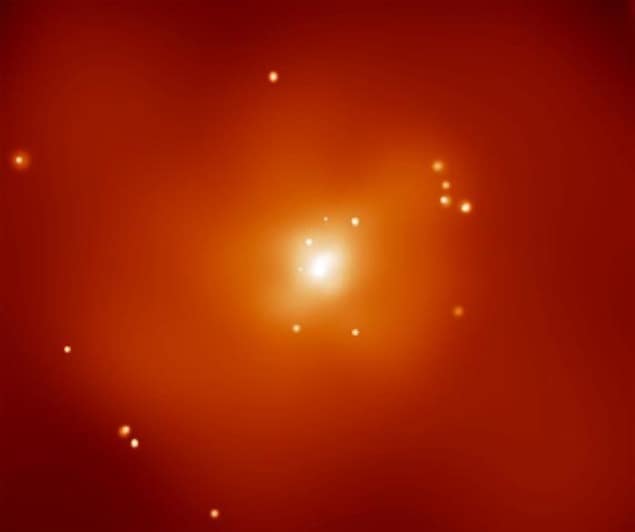
An alternative theory to dark matter has successfully predicted the rotational properties of two elliptical galaxies. The work was done in Israel by Mordehai Milgrom using the modified Newtonian dynamics (MOND) theory that he first developed nearly 30 years ago. By showing that MOND can be used to explain the properties of complicated elliptical galaxies – as well the much simpler spiral galaxies – Milgrom argues that MOND offers a viable alternative to dark matter when it comes to explaining the bizarre properties of galaxies.
Dark matter was proposed in 1933 to explain why galaxies in certain clusters move faster than would be possible if they contained only the “baryonic” matter that we can see. A few decades later, similar behaviour was detected in individual galaxies, whereby the rotational velocity of the outermost stars was found not to “drop off” as a function of distance but instead remain flat. These observations directly contradicted Newtonian gravity, which should hold true in extragalactic regions just as it does on Earth and in the solar system. But by assuming there are “haloes” of invisible matter in and around galactic structures, Newton’s familiar inverse square law is restored.
Since it was first invoked to explain these galactic irregularities, physicists have tried to make direct measurements on dark matter to try to work out exactly what it is – with very little success. As a result, there are some researchers who do not believe that dark matter exists and have proposed alternative explanations for the strange behaviour of galaxies.
Spectacular success
Now a new analysis suggests that one alternative theory called MOND describes the properties of two elliptical galaxies just as well as dark matter. MOND was originally formulated to describe spiral galaxies and has had spectacular success in predicting certain properties of these structures. Its extension to cover elliptical galaxies could strengthen the arguments in favour of this alternative theory. This is because elliptical galaxies are predicted to have formed by a different process from spiral galaxies and their properties are much more difficult to calculate.
MOND was first proposed in 1983 by the astrophysicist Mordehai Milgrom of the Weizman institute in Israel. The basic premise of the theory is that at extremely small accelerations of less than 10–10 m s–2 Newton’s second law does not hold. Instead, Milgorm modified Newton’s formula so that under certain circumstances the gravitational force between two bodies decays more gently than the inverse square of the distance between them.
Predictably, a theory that advocates changing Newton’s laws is destined to meet with widespread scepticism, and MOND is no exception. Nevertheless, it also has undeniable attractions, such as the ease with which it makes testable predictions and the fact that it does not rely on an as-yet unseen dark matter. And, since a version of MOND consistent with Einstein’s general theory of relativity was derived in 2004 by Jacob Bekenstein of the Hebrew University of Jerusalem, the wider physics community has begun to take notice.
No coincidence
In the new research, Milgrom analyses the hydrostatics of a spherical envelope of hot, X-ray emitting gas in two elliptical galaxies and shows the predictions of MOND are equally valid in these. This is important, Milgrom argues, because elliptical galaxies are thought to have evolved in a completely different way from spiral galaxies and other disc galaxies – they are thought to be formed by the collision and merging of two other galaxies. MOND’s success, he argues, means that its predictive accuracy cannot simply be a coincidence and that it must hint at a deeper underlying truth.
He also suggests that the fact that the same mathematical law can be used to predict the rotation speeds of two different types of galaxies formed in two different ways significantly undermines the dark-matter hypothesis. “In the dark-matter picture” he says, “The galaxies we see today are the end result of very complicated and very haphazard formation processes. You start with small galaxies – they merge, they collide – there are explosions in the galaxies and so on and so forth. During this stormy evolution the dark matter and the normal matter are subject to these processes in very different ways and so you really do not expect to see any real correlations between the dark matter and the normal matter. This is a very weak point of the dark-matter picture.”
Particle astrophysicist and dark-matter expert Dan Hooper of Fermilab in the US, argues that MOND will not win over sceptics by showing its applicability to galaxies, even if those galaxies are of types that have not been previously tested. “I have found it to be the case for quite some time now that MOND does a very good job of explaining the dynamics of galaxies,” he says. “And this paper is yet another example of where MOND succeeds at the galactic scale. Where MOND fails is on larger scales such as in clusters of galaxies and on even larger cosmological scales.” He cites the anisotropy of the cosmic-microwave background as one example of this.
The research is published in Physical Review Letters.



